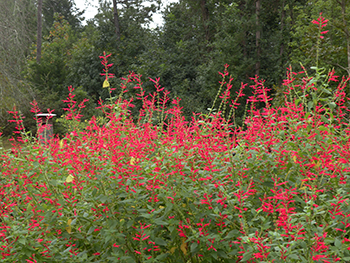
By Terry W. Johnson
If you enjoy gardening for hummingbirds, you should become acquainted with the salvias. Salvias and hummingbirds are so mutually beneficial to one another that wildlife gardeners sometimes refer to them as the perfect pair.
Depending on which plant taxonomist you talk to, there are anywhere from 700-3,000 types of salvias. Many of these plants are grown in gardens throughout Georgia. One of the noteworthy salvias is pineapple sage (Salvia elegans). A key trait that sets it apart, depending on where you live in the Peach State, is its blooming period. This plant, named for the sweet scent of it foliage, blooms from summer into fall and beyond. In comparison, most native and ornamental salvias bloom from spring into the summer.
I confess I did not even know pineapple sage existed until I began banding wintering hummingbirds some three decades ago. Often when I visited the homes of folks hosting winter hummingbirds (particularly in south Georgia), I found pineapple sage plants covered with bright red tubular-shaped blossoms. Realizing this was probably no coincidence, I made a point of finding out as much as could about this showy plant.
While native to Central America, pineapple sage is not invasive. As such, it’s a great source of food for hummingbirds and butterflies, and one that adds a splash of color. In addition to its attractive foliage and flowers, gardeners enjoy the pineapple scent that fills the air when they crush its leaves. The plant is also serves as a seasoning for food, and adds flavor to beverages, jams and jellies.
Pineapple sage is a perennial. However, throughout much of Georgia gardeners typically treat it as an annual. This is because it is susceptible to cold weather. But when mulched during winter, the plant can survive temperatures as low as 5 degrees Fahrenheit. Mulch soon after the first frost in autumn. Cutting back the plant’s dead stems to within a few inches of the ground before mulching will lead in spring to a bushier plant that produces more blooms.
In south Georgia, many gardeners tell me their pineapple sage survives the winter cold in that region without mulching. In comparison, people in the rest of the state typically mulch their plants. However, whether pineapple sage plants survive without mulching seems also dependent on where you live in a county.
For example, I live just above the Fall Line on the western side of Monroe County. Georgia DNR’s Wildlife Conservation Section office is on Rum Creek Wildlife Management Area in the eastern half of the county. A row of pineapple sage has been growing along the walkway there for many years. These hardy plants have never been mulched. Yet, they have survived many winters. In my yard on the other side of the county, only one pineapple sage plant has survived without winter mulching.
To ensure we have pineapple sage plants ready for transplanting each spring, my wife roots cuttings taken from plants grown during late summer or early fall. The next spring, after the chance of frost has passed, she transplants the young plants directly into the ground or in large containers.
One advantage of planting pineapple sage in containers is you can move the plants to protected locations when frost is on the way. This can extend the plants' blooming period, prolonging how long they benefit nectar feeders. Last year, when a hard frost was forecast for my area in early December, we moved the pineapple sage growing in pots across the yard onto our deck. The frost killed most of the plants still flowering in our yard. But of the few nectar plants still bearing flowers, many were the pineapple sage plants growing in large pots lined against the back wall of our home.
We moved the containers back into the yard the next morning. Within minutes, a cloudless sulphur was nectaring on the blossoms. Later it was joined by a gulf fritillary. The pots with pineapple sage had become living butterfly feeders.
Pineapple sage grows 3 to 4 feet tall and up to 4 feet wide. It seems to prosper in spots that receive both morning and afternoon sun. Also, it does best in well-drained soil.
It is easy to understand why pineapple sage is so popular with hummingbirds. The flowers are scarlet red and produce nectar in long tubular-shaped blossoms. While hummingbirds collect nectar a variety of flower shapes and colors, they seem to have an affinity for blooms that are red and tube-shaped.
It should also be noted that butterflies, particularly sulphur butterflies such as the cloudless sulphur, also feed at pineapple sage blossoms.
A strong case could be made that the pineapple sage's most redeeming virtue is that it provides food for butterflies and hummingbirds in late summer and fall when nectar is often scarce.
If you have not already found a place in your garden for pineapple sage, I hope you will consider doing so this spring. Try it and you will not only enjoy its beauty, but hummingbirds and butterflies will benefit from the nectar the plant generates – and the salvia will benefit from the pollinators that unwittingly carrying its pollen from plant to plant.
Whatever you do, don’t wait as long as I did to discover the merits of this special plant.
Terry W. Johnson is a retired Nongame program manager with the Wildlife Resources Division and executive director of The Environmental Resources Network, or TERN, friends group of the division’s Nongame Conservation Section. (Permission is required to reprint this column.) Learn more about TERN, see previous “Out My Backdoor” columns, read Terry’s Backyard Wildlife Connection blog and check out his latest book, “A Journey of Discovery: Monroe County Outdoors.”